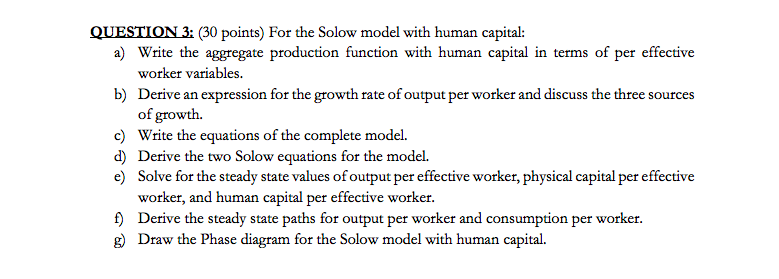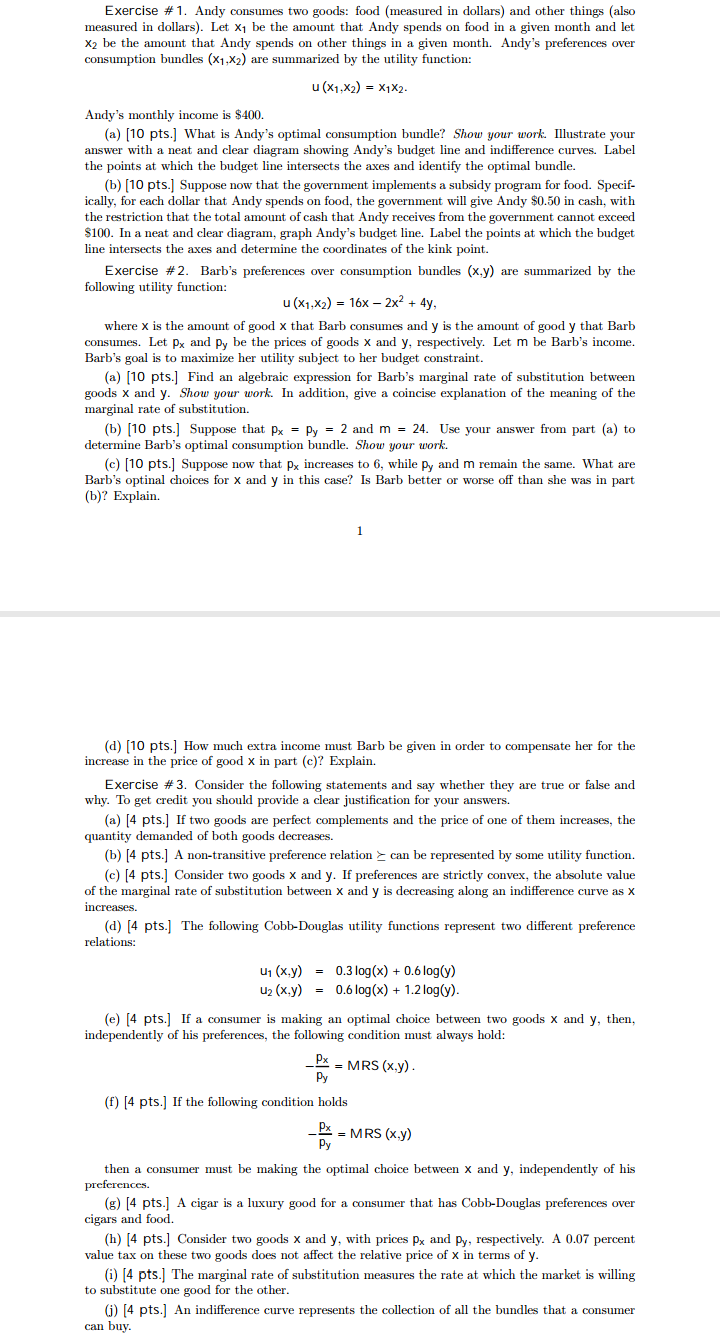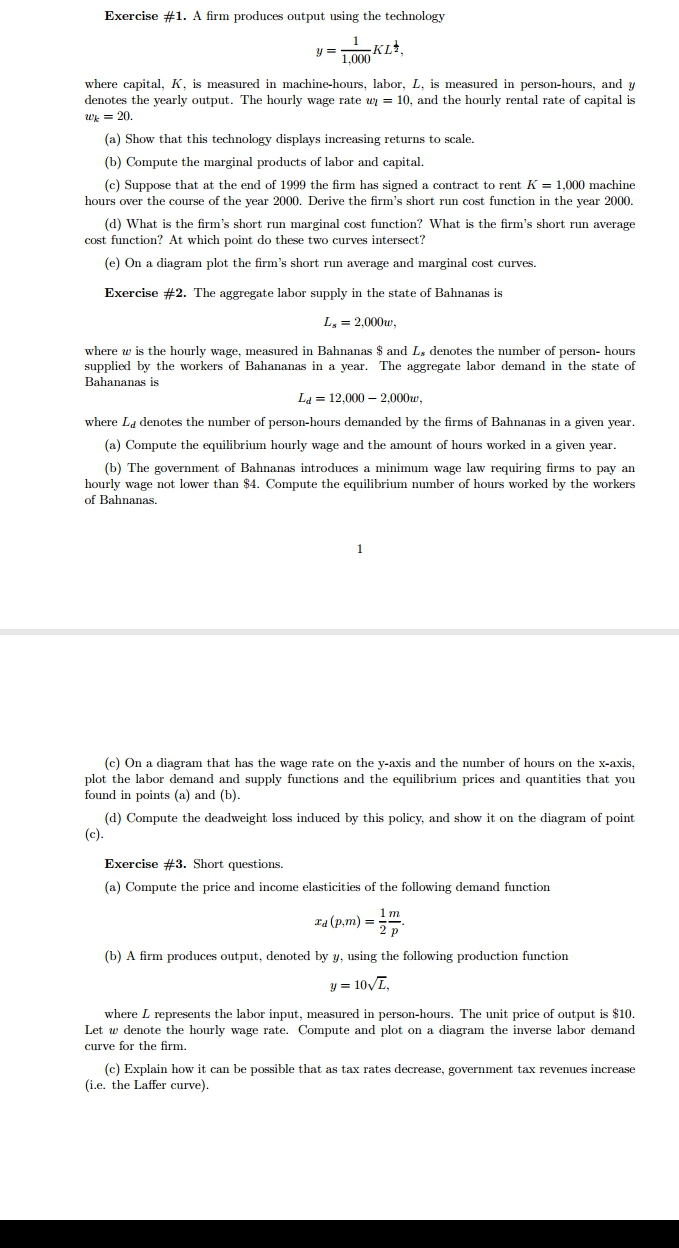



Eco nomics
Human lCapital Model: Fieinterpretthe human capital growth model as follows: Suppose there are two groups of people in a country, the lowskilled and the highskilled, where the lowskilled have less human capital per person initially than the highskilled. Each type of worker produces output independently from the other, using efficiency units of labor and total factor productivity, 2, which is assumed to be common across groups. Each individual in this economy accumulates human capital on their own,1 and each has one unit of time to split between human capital accumulation and work. Assume that the high skilled have initially higher efficiency of learning: bh :> bl , and that uh 6: ul . {a} In all developed countries, there has been an increase in the socailed skill premium, the gap between the wages of highskilled workers and lowskilled workers, over the last 3G years. Determine how this model can explain this observation. QUESTION 3: (30 points) For the Solow model with human capital: a) Write the aggregate production function with human capital in terms of per effective worker variables. b) Derive an expression for the growth rate of output per worker and discuss the three sources of growth. c) Write the equations of the complete model. d) Derive the two Solow equations for the model. e) Solve for the steady state values of output per effective worker, physical capital per effective worker, and human capital per effective worker. f) Derive the steady state paths for output per worker and consumption per worker. g) Draw the Phase diagram for the Solow model with human capital.Exercise #1. Andy consumes two goods: food (measured in dollars) and other things (also measured in dollars). Let x1 be the amount that Andy spends on food in a given month and let X2 be the amount that Andy spends on other things in a given month. Andy's preferences over consumption bundles (X1,X2) are summarized by the utility function: u (X1,X2) = X1X2. Andy's monthly income is $400. a) [10 pts.] What is Andy's optimal consumption bundle? Show your work. Illustrate your answer with a neat and clear diagram showing Andy's budget line and indifference curves. Label the points at which the budget line intersects the axes and identify the optimal bundle. (b) [10 pts.] Suppose now that the government implements a subsidy program for food. Specif- ically, for each dollar that Andy spends on food, the government will give Andy $0.50 in cash, with the restriction that the total amount of cash that Andy receives from the government cannot exceed $100. In a neat and clear diagram, graph Andy's budget line. Label the points at which the budget line intersects the axes and determine the coordinates of the kink point. Exercise #2. Barb's preferences over consumption bundles (x,y) are summarized by the following utility function: u (X1,X2) = 16x - 2x2 + 4y, where x is the amount of good x that Barb consumes and y is the amount of good y that Barb consumes. Let Px and Py be the prices of goods x and y, respectively. Let m be Barb's income. Barb's goal is to maximize her utility subject to her budget constraint. (a) [10 pts.] Find an algebraic expression for Barb's marginal rate of substitution between goods x and y. Show your work. In addition, give a coincise explanation of the meaning of the marginal rate of substitution. (b) [10 pts.] Suppose that Px = Py = 2 and m = 24. Use your answer from part (a) to determine Barb's optimal consumption bundle. Show your work. (c) [10 pts.] Suppose now that Px increases to 6, while Py and m remain the same. What are Barb's optinal choices for x and y in this case? Is Barb better or worse off than she was in part (b)? Explain. (d) [10 pts.] How much extra income must Barb be given in order to compensate her for the increase in the price of good x in part (c)? Explain. Exercise # 3. Consider the following statements and say whether they are true or false and why. To get credit you should provide a clear justification for your answers. (a) [4 pts.] If two goods are perfect complements and the price of one of them increases, the quantity demanded of both goods decreases. (b) [4 pts.] A non-transitive preference relation > can be represented by some utility function. (c) [4 pts.] Consider two goods x and y. If preferences are strictly convex, the absolute value of the marginal rate of substitution between x and y is decreasing along an indifference curve as x increases. (d) [4 pts.] The following Cobb-Douglas utility functions represent two different preference relations: U1 (x,y) = 0.3 log(x) + 0.6log(y) U2 (x,y) = 0.6 log(x) + 1.2 log(y). (e) [4 pts.] If a consumer is making an optimal choice between two goods x and y, then, independently of his preferences, the following condition must always hold: Py Px = MRS (x,y) . (f) [4 pts.] If the following condition holds Py Px = MRS (x,y) then a consumer must be making the optimal choice between x and y, independently of his preferences. (g) [4 pts.] A cigar is a luxury good for a consumer that has Cobb-Douglas preferences over cigars and food. (h) [4 pts.] Consider two goods x and y, with prices Px and Py, respectively. A 0.07 percent value tax on these two goods does not affect the relative price of x in terms of y. (i) [4 pts.] The marginal rate of substitution measures the rate at which the market is willing to substitute one good for the other. (i) [4 pts.] An indifference curve represents the collection of all the bundles that a consumer can buy.Exercise #1. A firm produces output using the technology y = 7 1.000 where capital, K', is measured in machine-hours, labor, L, is measured in person-hours, and y denotes the yearly output. The hourly wage rate wy = 10, and the hourly rental rate of capital is Wk = 20. (a) Show that this technology displays increasing returns to scale. (b) Compute the marginal products of labor and capital. (c) Suppose that at the end of 1999 the firm has signed a contract to rent K = 1,000 machine hours over the course of the year 2000. Derive the firm's short run cost function in the year 2000. (d) What is the firm's short run marginal cost function? What is the firm's short run average cost function? At which point do these two curves intersect? (e) On a diagram plot the firm's short run average and marginal cost curves. Exercise #2. The aggregate labor supply in the state of Bahnanas is Ls = 2,000ur, where w is the hourly wage, measured in Bahnanas $ and Ls denotes the number of person- hours supplied by the workers of Bahananas in a year. The aggregate labor demand in the state of Bahananas is La = 12,000 - 2,000ur, where La denotes the number of person-hours demanded by the firms of Bahnanas in a given year. (a) Compute the equilibrium hourly wage and the amount of hours worked in a given year. (b) The government of Bahnanas introduces a minimum wage law requiring firms to pay an hourly wage not lower than $4. Compute the equilibrium number of hours worked by the workers of Bahnanas. (c) On a diagram that has the wage rate on the y-axis and the number of hours on the x-axis, plot the labor demand and supply functions and the equilibrium prices and quantities that you found in points (a) and (b). (d) Compute the deadweight loss induced by this policy, and show it on the diagram of point (c). Exercise #3. Short questions. (a) Compute the price and income elasticities of the following demand function Ed (p.m) = 2p (b) A firm produces output, denoted by y, using the following production function y = 10VL, where L represents the labor input, measured in person-hours. The unit price of output is $10. Let w denote the hourly wage rate. Compute and plot on a diagram the inverse labor demand curve for the firm. (c) Explain how it can be possible that as tax rates decrease, government tax revenues increase (i.e. the Laffer curve)














